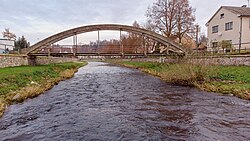The Divoká Orlice (Polish: Dzika Orlica, German: Wilde Adler) is a river in the Czech Republic and Poland. It flows through Lower Silesian Voivodeship in Poland and through the Hradec Králové and Pardubice regions. It is the upper and middle course of the Orlice, but usually it is considered a separate river. Until its confluence with the Tichá Orlice, when it further continues as the Orlice, the Divoká Orlice is 99.3 km (61.7 mi) long.
| Divoká Orlice | |
|---|---|
 The Divoká Orlice in Žamberk | |
 | |
| Location | |
| Countries | |
| Regions/ Voivodeships | |
| Physical characteristics | |
| Source | |
| • location | Szczytna, Bystrzyckie Mountains |
| • elevation | 802 m (2,631 ft) |
| Mouth | |
• location | Orlice |
• coordinates | 50°21′30″N 16°26′5″E / 50.35833°N 16.43472°E |
• elevation | 249 m (817 ft) |
| Length | 99.3 km (61.7 mi) |
| Basin size | 806.5 km2 (311.4 sq mi) |
| Discharge | |
| • average | 11.5 m3/s (410 cu ft/s) near estuary |
| Basin features | |
| Progression | Orlice→ Elbe→ North Sea |
Etymology
editThe name Orlice is derived from the Slavic word orel, i.e. 'eagle' (literally "female eagle"). The river probably got its name from the abundance of eagles, but it could also have just been the accidental catch of an eagle. The attribute divoká means 'wild' and refers to its character (compared to Tichá Orlice, i.e. "silent Orlice"). The Divoká Orlice was also called Dravá Orlice (i.e. 'ferocious', 'fierce').[1][2]
Characteristic
editFrom a water management point of view, the Orlice and Divoká Orlice are two different rivers with separate numbering of river kilometres. The Divoká Orlice originates in the territory of Szczytna in the Bystrzyckie Mountains at an elevation of 802 m (2,631 ft) and then flows to Žďár nad Orlicí, where it merges with the Tichá Orlice River at an elevation of 249 m (817 ft) and continues as Orlice. It is 99.3 km (61.7 mi) long, of which 3.2 km (2.0 mi) (excluding the Czech-Polish border) is in Poland. It forms the state boundary for a distance of 29.5 km (18.3 mi)[3] and separates the Bystrzyckie Mountains and Orlické Mountains. Its drainage basin has an area of 806.5 km2 (311.4 sq mi), of which 705.9 km2 (272.5 sq mi) is in the Czech Republic.[4][5]
The longest tributaries of the Divoká Orlice are:[6]
| Tributary | Length (km) | River km | Side |
|---|---|---|---|
| Bělá | 40.6 | 12.3 | right |
| Zdobnice | 33.9 | 21.7 | right |
| Brodec | 19.8 | 8.1 | left |
| Rokytenka | 19.0 | 44.8 | right |
Flow
editThe river flows through the territories of the gminas Szczytna, Bystrzyca Kłodzka and Międzylesie in Poland and through the municipal territories of Orlické Záhoří, Bartošovice v Orlických horách, Klášterec nad Orlicí, Pastviny, Nekoř, Líšnice, Žamberk, Helvíkovice, Záchlumí, Potštejn, Záměl, Doudleby nad Orlicí, Kostelec nad Orlicí, Častolovice, Čestice, Lípa nad Orlicí and Žďár nad Orlicí in the Czech Republic.
Bodies of water
editThere are 376 bodies of water in the basin area. The largest of them is Pastviny I Reservoir with an area of 63 ha (160 acres), built directly on the Divoká Orlice.[4]
Tourism
editThe Divoká Orlice is suitable for river tourism and belongs to the rivers suitable for less experienced paddlers.[7]
See also
editReferences
edit- ^ Loucká, Pavla (1997-09-05). "Řeky si pojmenovali nejdřív" (in Czech). Vesmír. Retrieved 2023-10-05.
- ^ "Řeka Orlice – dvě řeky v jednu spojené" (in Czech). CzechTourism. Retrieved 2023-10-05.
- ^ "Čestice – Povodňový plán obce: Hydrologické údaje". Elektronický digitální povodňový portál (in Czech). Retrieved 2023-10-05.
- ^ a b "Základní charakteristiky toku Divoká Orlice a jeho povodí" (in Czech). T. G. Masaryk Water Research Institute. Retrieved 2023-10-05.
- ^ "Povodňový plán obce Záměl: Hydrologické údaje". Portál obce (in Czech). Retrieved 2023-10-05.
- ^ "Vodní toky". Evidence hlásných profilů (in Czech). Czech Hydrometeorological Institute. Retrieved 2024-10-16.
- ^ Hocek, Jan (2014-08-29). "Divoká Orlice. Řeka bez hospod a jezů je ideální pro vodácké novice" (in Czech). iDNES.cz. Retrieved 2023-10-05.
External links
edit- River flow at Kostelec nad Orlicí station – Flood Warning and Forecasting Service of the Czech Hydrometeorological Institute